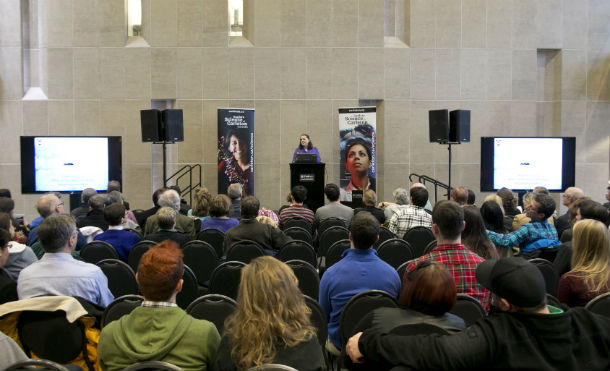- Home
- About
- Prospective Students
- Current Students
- Science Student Success Centre
- Science Learning Communities
- Info for Faculty and Staff
- Giving to Science
- Research and research opportunities
- Conferences and educational opportunities abroad
- Public Lectures
- Science Viewbook
- Science Cafes
- Eureka Magazine
- Explore Science @ Carleton eNewsletter
- Contact Us
Carleton Students Tell Tales about the Great White South
Thursday, March 20, 2014
Story written by Susan Hickman
After passing through the deepest and coldest waters on Earth, walking with chinstrap penguins and sailing up close to a 60-metre high iceberg, 13 Carleton students have returned home to tell their tales of adventure.
“Going to Antarctica is like going to another planet,” says Geoff Green, Canadian adventurer and environmentalist as well as founder of the organization Students on Ice that has, since 2000, taken more than 2,500 students from 50-plus countries on educational expeditions to the Arctic and Antarctica.
“She never fails to deliver,” Green said of the Antarctic continent, addressing a crowd of about 180 who came to hear stories on Wednesday from Earth Sciences Prof. Claudia Schröder-Adams and 12 of the 13 students who journeyed there in January.
The students provided a scientific diary of their trip from Ushuaia at the southernmost tip of Argentina to the South Shetland Islands and the Antarctic Peninsula aboard the oceanographic research vessel MV Ushuaia, as well as lessons about the continent’s geological history, climate and ecosystems.
They endured the long journey through the moody Drake Passage, which separates Antarctica from South America, worried over the durability of the ship when a chunk of ice broke a propeller, sat atop a tabular glacier, and saw an impressive number of whales, seals, penguins and majestic albatrosses with enormous wingspans.
“On Halfmoon Island,” recalled geology student Brent Clark, “I sat alone on a beach, listening to the silence -- and the cracking and popping of the glaciers -- and it made me realize how truly small we are in this world.
“This trip has taught me life is about pushing beyond your comfort zone,” said Clark. “As you take that next step, you realize who you are as a person and that you are capable of achieving anything.”
Not solely a tourist adventure, the Antarctic trip provided first-hand evidence of the effect of the movement of the Earth’s tectonic plates, climate change and evolution of ecosystems over the millennia, through the study of sedimentary deposits, fossils and other paleontological indications.
“Antarctica is challenging for geologists,” said Danielle Dionne, an Earth Sciences master’s student who explained that Antarctica was once a lush, green subtropical region, surrounded on all sides by other continents that have since drifted away. “It’s all ice and there is very little exposed rock.”
Seymour Island, a rare site where the Cretaceous/Tertiary boundary is exposed, documents the extinction of the dinosaurs. “It’s an amazing source of data,” Dionne added. “Coal seams are evidence of abundant vegetation, as are its in situ forests and its diverse fossil plants and beautifully preserved tree rings.”
The fragile polar regions are considered “ground zero” for climate change and their geology is of great value to researchers and scientists.
The international Antarctica treaty, which governs its exploitation, is a “human triumph,” says Matthew Russell, a PhD student in the Department of Civil and Environmental Engineering. “Astounding contributions to science are being made through international collaborative projects that are the largest in the world. Its thin, dry, stable atmosphere is a unique environment for cosmological research.
“For a tourist, a scientist, anybody with a stake in living on planet Earth, Antarctica gives us a unique position to help us understand our planet.”
The other students who completed the trip are Cassandra Cheung, Jasmine Clancy, Eric James Hickie, Anna Labudzka, Jamie Marchesi, David Melanson, Phill Snable, Jordan Thoms, Matt Trenkler and Lianna Vice.
